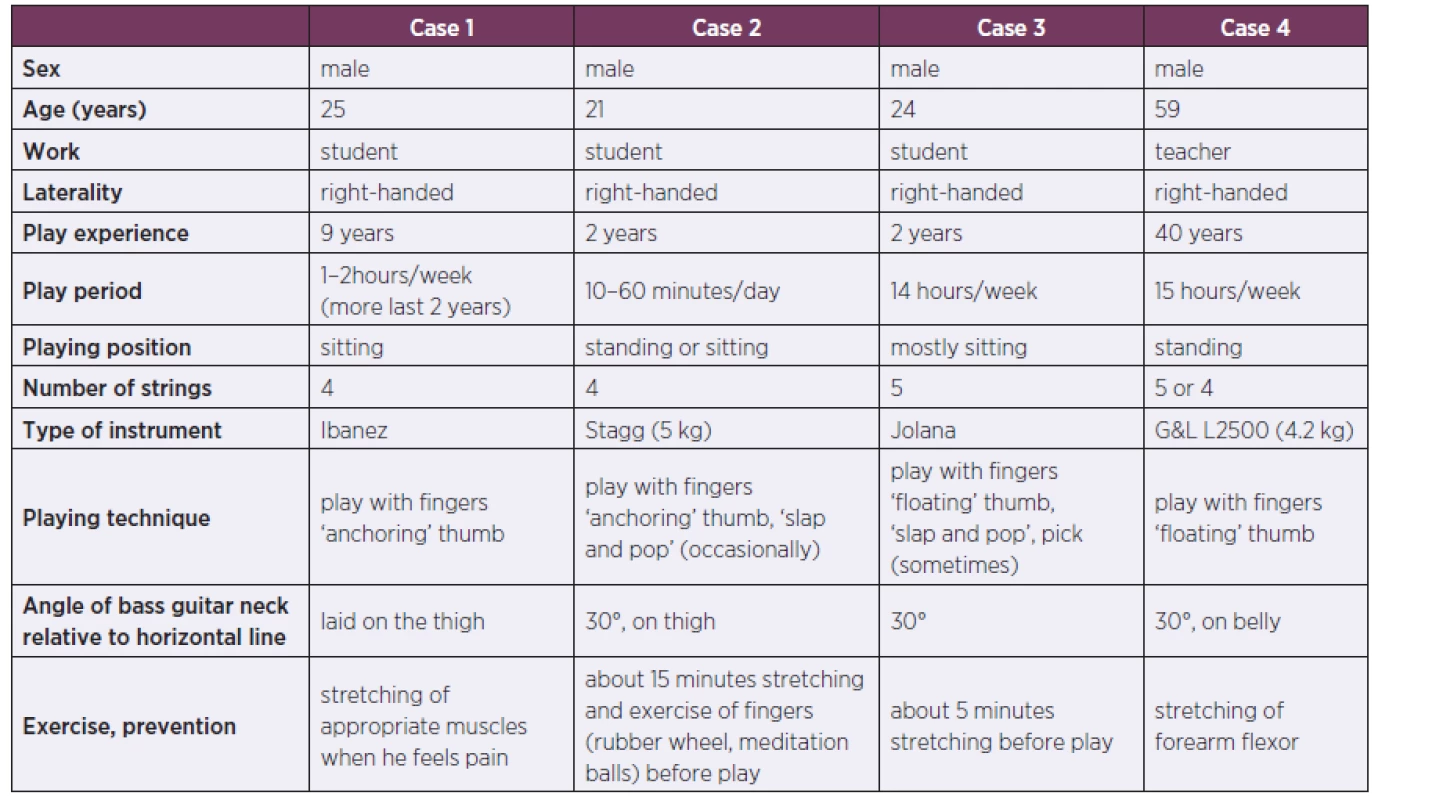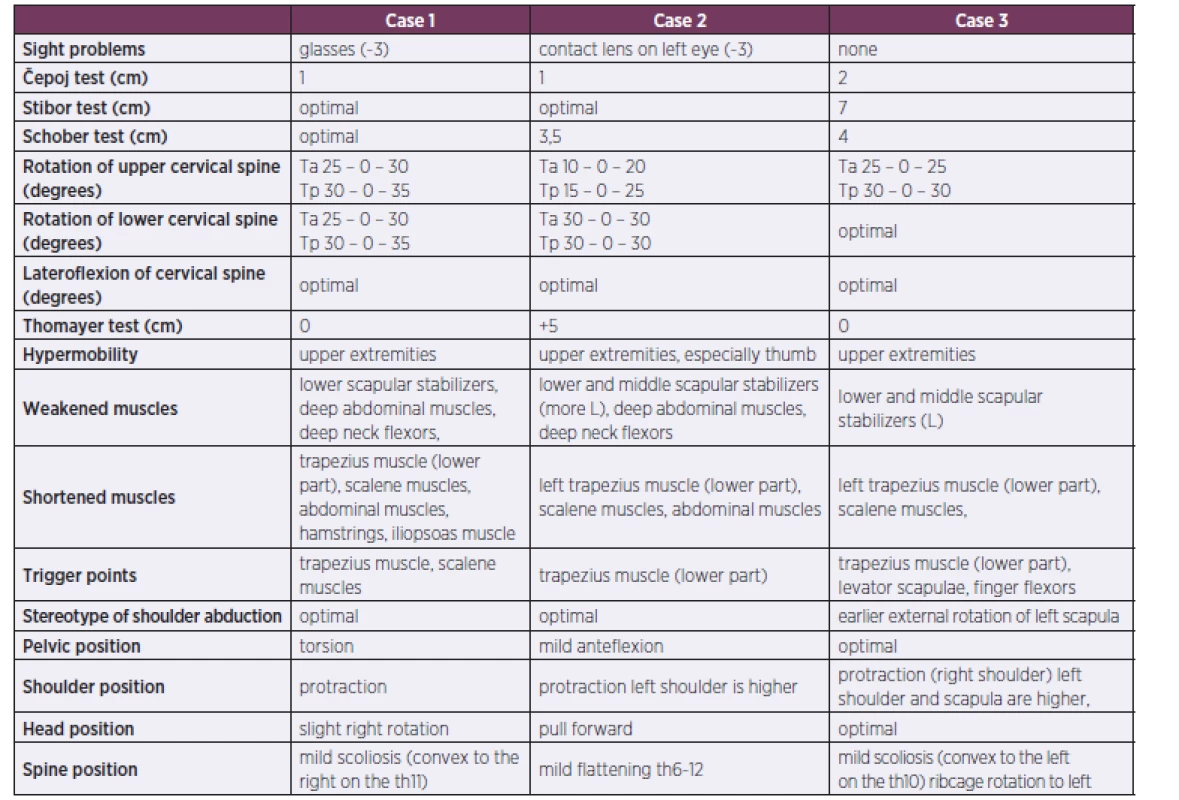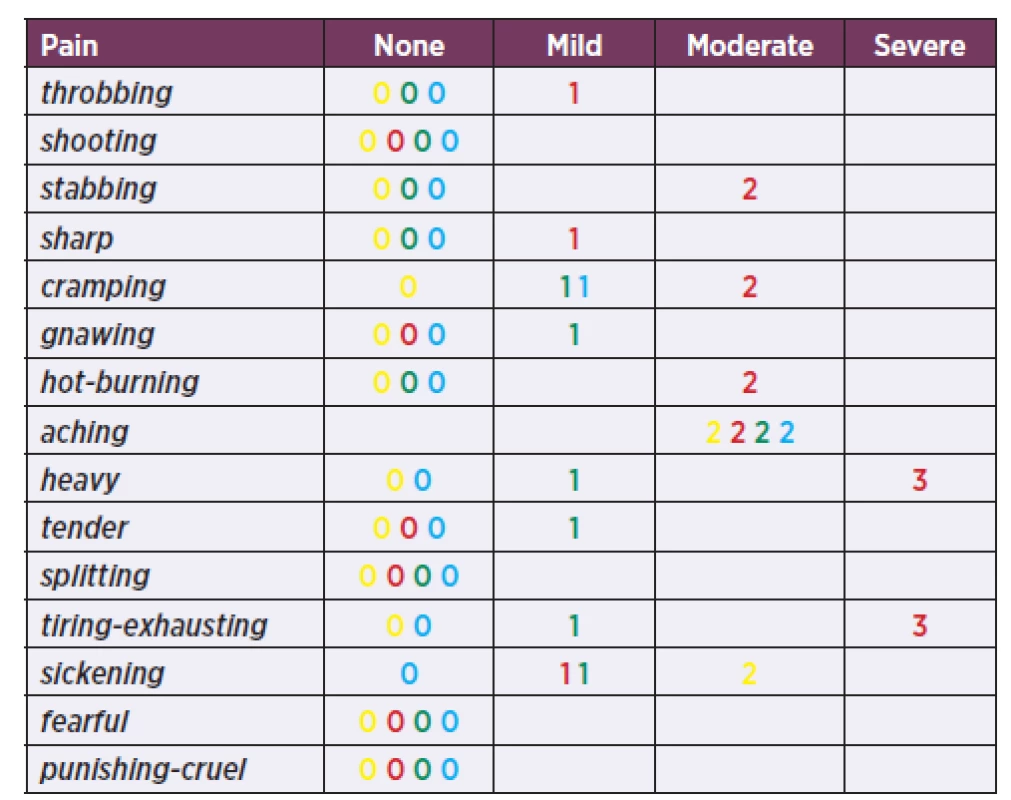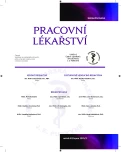Pathokinesiological changes in the musculoskeletal system in bass guitar players – importance of prevention: a case series and review of literature
Authors:
J. Klugarová 1,2; T. Gregorová 3; M. Klugar 1; R. Kertz 4; J. Marečková 1,2
Authors‘ workplace:
The Czech Republic (Middle European) Centre for Evidence-Based Health Care: An Affiliated Centre of The Joanna Briggs Institute, Department of Social Medicine and Public Health, Faculty of Medicine and Dentistry, Palacky University Olomouc
1; Centre for Research and Science, Faculty of Health sciences, Palacky University Olomouc
2; Faculty of Physical Culture, Olomouc
3; Health Care Specialists Ltd., USA
4
Published in:
Pracov. Lék., 67, 2015, No. 2, s. 38-45.
Category:
Original Papers
Overview
The purpose of this case series was to find out how asymmetrical loading by regularly playing the electric bass guitar can cause musculoskeletal problems.
Participants for this case series were three Czech and one Dutch males who play the bass guitar on a regular basis. Anamnestic data were collected from all of them, and kinesiological examination was done for three of them. For purposes of this study, the players completed the Short-form McGill University pain questionnaire and the Pain map.
Results of the case series showed that bass guitarists tended to exhibit muscle shortening and development of myofascial changes (trigger points) in the upper left trapezius muscle, with accompanying left shoulder pain, wrist and finger pain, protraction of the shoulder blade (notably the right), pronounced chest rotation to the left and reduction of cervical spine mobility. The upper cross syndrome appeared in two participants and lower back pain in one of them. An emotional component accompanied the pain particularly in less experienced players.
Manifestation of changes in the musculoskeletal system in bass guitar players is related not only to the weight of the bass guitar but also to playing position, playing technique, and length and frequency of playing.
Keywords:
bass guitar – playing technique – pathokinesiology – musculoskeletal system – prevention
BACKGROUND
Bass guitar is not one of the most frequently used instruments by musicians; however due to its significant weight and length it influences the musculoskeletal system of the player more quickly than other string instruments (e. g. guitar) [1]. This study focused on the electric bass, because at present it is the most frequently used among bass playing musicians [2].
In the correct position of the fretting hand, or left hand in right handed musicians, the interphalangeal and metacarpophalangeal joints are flexed, fingers are laid on one string perpendicularly to the axis of the neck, the thumb is held in a curve, the palm does not touch the neck of the instrument and is open, the wrist is in slight palmar flexion (about 5°) and ulnar deviation, and the elbow in flexion less than 135° [3, 4]. One of the correct positions of the fretting hand is shown in Figure 1. One inadvisable position of the right or plucking or picking hand is, according to Kertz [3], having the elbow close to the ribs, the forearm resting on the edge of the instrument body, and the wrist bent sharply down toward the strings with excess ulnar deviation (Figure 2). The instrument in this position causes the right hand to be placed in excess flexion which leads to nerve compression including carpal tunnel syndrome due to resting the hand on the upper edge of the instrument.


Finger style playing techniques use different muscles (flexors of the wrist, second and third finger), than the “slap and pop” technique (supinators and pronators of the forearm, thumb flexors and abductor), while others are used for playing with a pick (supinators and pronators of the forearm, flexors of the first, second and third fingers) (Figure 3). Additionally, Kertz [3] describes the use of a ‘floating’ thumb technique (Figure 4) rather than an ‘anchored’ one. It is also recommended to play the bass guitar in a standing position with the instrument on an appropriately set strap than in sitting position with the instrument rested on the thigh.

Although a musician plays technically in a correct way, some health problems may occur. The most common problems are reflex changes in soft tissues in the area of the shoulder girdle, nape and forearm, low back pain, radicular syndromes in the upper extremities, upper crossed syndrome, impingement syndrome, rotator cuff tear, bursitis and repetitive strain injury (RSI). Problems formed by RSI include nerve entrapment syndromes in the upper extremities (thoracic outlet syndrome, carpal, cubital and radial tunnel syndrome) and enthesopathy of the tendons of the flexor and extensor muscle groups of the forearm (golfers and tennis elbow). Nodular cysts, arthritis, Dupuytren’s contracture, trigger finger, focal dystonia on upper extremities or blisters may also appear [5, 6]. There is no evidence of a direct relationship between the appearance of Dupuytren’s contracture and playing the bass guitar. The biggest danger in playing the bass guitar is RSI, especially carpal tunnel syndrome and tendinitis of the forearm musculature, which the player uses repeatedly in playing situations [3, 7].
Generally, problems caused by activities with asymmetrical loading can be avoided by adopting proper technique and posture based on the Back School [8]. Fjellman-Wiklund and Chesky [1], Kertz [3] and Horvath [7] highlighted importance of proper playing technique and posture in bass guitar players and recommended to combine this with proper rest and exercise, a short warm-up before playing, timely intervals during play and stretching after playing.
The aim of this case series was to examine how asymmetrical loading of the musculoskeletal system by regularly playing the electric bass guitar can affect the function of this system.
METHODS
The case series used consisted of four bass guitar players (3 Czech and 1 Dutch males; 32.25 ± 17.91 years). Three of them were students at a Palacký University, and the oldest one was a bass guitar teacher.
All participants filled out the short-form McGill University pain questionnaire [9] and a Pain map, and anamnestic data was taken from them. We conducted complex kinesiological examinations on three of them, while the last participant was not from the Czech Republic, therefore the kinesiological examination could not be performed.
The anamnesis was focused on information focused on playing the bass guitar, especially on laterality, playing experience and period, number of strings and the weight of their instruments. In addition, we were interested in their preferred technique of play and angle of the neck of the bass guitar in relation to the horizontal position; we also asked if participants do any regular exercises or do anything for warm-up before playing and if they take breaks between song pieces (Table 1).
Kinesiological examination consisted of posture alignment and position assessed by observation and palpation [10, 11]. We also examined spinal mobility (Thomayer test = finger-to-floor distance; Schober test; Stibor test = thoracolumbar flexion; thoracolumbar lateral flexion = finger-thight test; Otto inclination and reclination test = thoracic flexion and extension; cervical lateral flexion; cervical rotation; Čepoj test = cervical flexion; Lenoch test = chin-coronoideus-claviculae distance) [12, 14]. According to Janda [15] and Kolar [14] we examined the presence of reflex changes in muscles, shortened muscles, stereotype of abduction in the shoulder joint and hypermobility. Then we tested the stretch reflexes, performed tests for entrapment syndromes (Tinel’s sign, Phalen’s test, Adson’s test), and superficial and deep sensation on the upper extremities [11, 16, 17].
The obtained data was processed based on frequency of occurrence.
RESULTS
Information from anamnesis of all participants can be seen in Table 1. All participants had a dominant right hand. The angle of the neck of the bass guitar relative to the horizontal was 30° for three participants when they played in a standing position. One musician played only sitting, one only standing, the other two switched the positions. Participants who played while standing had milder difficulties. Participants who used a five-string instrument played with fingers and the ‘floating’ thumb technique and occasionally played in ‘slap and pop’ style. The other two musicians used a four-string instrument and played with an ‘anchored’ thumb style. The playing time varied from 10–60 minutes per day to 15 hours per week. The experience in playing increased with the age of participants. The heavier the instrument was, the more significant were the health problems.

The results of the kinesiological examination of participants 1–3 are shown in Table 2. All three participants had reduced mobility of the cervical flexion (Čepoj test) and in rotation, hypermobile upper extremities, protraction of the right shoulder and weakened middle and lower left scapular stabilizers. We found a tendency toward reflex changes (trigger points) in the lower part of the left trapezius muscle and in the scalene muscles. All participants tried to do some exercise, but only participant 2 did preventive stretching exercises for the fingers. These were performed 15 minutes before play, and when the participant first started to play he began slowly, then played scales and only after that began to play the pieces.

The Short-form McGill pain questionnaire showed (Table 3) that all participants selected aching as a pain description in moderate strength. No one selected shooting, splitting or punishing as pain descriptors. Three participants chose cramping and sickening as pain descriptors in mild and moderate strength. Two participants selected heavy and tiring or exhausting pain descriptors in mild and severe strength. Only one participant chose throbbing, sharp, gnawing and tender as pain descriptors in mild or moderate strength. An emotional component of pain was strongly represented. Participants 2 and 3 chose the higher number of pain descriptors.

Three players felt the pain in the left shoulder. Two players felt the pain in the wrist and fingers, one in the elbow, but each of them on a different side (Figure 5).

The stretch reflexes, tests for entrapment syndromes (Tinel’s sign, Phalen’s test, Adson’s test), superficial and deep sensations on the upper extremities were normal.
DISCUSSION
Participants who had five-string instruments used finger style technique with a ‘floating’ thumb and from time to time also a ‘slap and pop’ technique. The other two participants had four-string instruments and played with a fixed thumb. The pain in the wrist and fingers increased in relation with the time of playing, age of the participants, and their playing experience. The fact, that musician using the ‘floating’ thumb technique, felt pain in the wrist and fingers may not have necessarily been caused by the use of this technique, but by longer period of play. An important feature is also the weight of the bass guitar, i. e. the heavier it is, the more significant the problems can be and the more efforts are necessary for their prevention and therapy.
One of the players used a seated position only, one the standing position only and the remaining two changed positions. The participants who played only in standing position experienced milder difficulties. This confirmed information by Kertz [3], that standing playing position is more suitable than the sitting one.
All three participants that underwent the kinesiological examination had reduced mobility of the cervical flexion (Čepoj test) and also in rotation. The reduced mobility of the cervical spine might be caused by the fact that the players usually watch the movements of their left (fretting) hand and in this way their heads are rotated to the left much of the time. Another factor that could influence the spine and the position of the head would be the presence of sight problems.
Three players described pain in their left shoulders with the presence of trigger points in the lower part of the left trapezius muscle and in the scalene muscles. The strap holding the bass guitar typically lays across the left shoulder, which causes continuous pressure on the shoulder by the weight of the instrument [18]. Although playing in the seated position reduces this pressure on the shoulder, it tends to cause other problems and in this way does not represent a practical solution.
In all examined participants we found protraction of the right shoulder. Protraction of the right shoulder, coupled in one participant with rotation of the chest to the left, could be caused by the fact that during playing the left arm moves in front of the body with the shoulder in continuous inner rotation. This could be, according to Kertz [3], at least partially reduced by shifting the instrument to the right side of the abdomen.
All three examined participants had weakened middle and lower left scapular stabilizers. This, together with weakening of the deep neck flexors (two participants) and hypertonic lower part of the trapezius muscle (three participants) indicate upper crossed syndrome. Due to asymmetrical loading, the muscle imbalance appeared on one side only.
The description of an emotional component of the pain was significant. Presence of the emotional component in the less experienced players could be caused by stress factors – by the stress of a new environment, unusual activity, non-economic movements or positions while playing or by stage-fright during public performances [19, 20].
Two players stated they experienced pain in the wrist and fingers, one of them in the elbow; additionally each of them complained about pain on the opposite side. The wrist and finger pain increased with time, while the shoulder pain decreased. This kind of pain could be caused by the wider neck of the five-string instrument, which forces the player to cock his fingers to their most extreme positions. Our findings showed that five-string instruments should be used by more experienced players, as familiarization with correct playing techniques prove to be less of a burden to the musculoskeletal system (‘floating’ thumb technique) and avoidance of incorrect body positioning would reduce likelihood of pain in the right shoulder. It would be useful to determine the neck width and depth of the instrument being played, as well as the spacing between the strings. The question that remains is whether this result was not distorted by participant 2, who exercised regularly. This would mean that regular exercise might prevent the development of pain in this region, which corresponds to evidence from Kertz [3].
One should not forget about other influences that were not addressed in this case series, such as the temperature of the environment in which the musicians usually play, stress factors, consumption of alcohol and food, and quality and duration of sleep [3, 21]. Moreover, the sample of bass guitar players used in this study was too small to say with any certainty detailed conclusions.
It would be useful to examine more bass guitar players and look into the influence of these and other factors on the development of musculoskeletal dysfunction. Another interesting study would be comparison of different playing techniques.
Lastly, we should mention that playing may be not the cause, but only the indicator of disease, the origin of which has nothing to do with playing the bass guitar [3].
CONCLUSION
From this case series we have concluded that common conditions seen in bass guitar players include shortening of musculature and formation of trigger points in the lower part of the trapezius muscle and in the scalene muscles, pain in the left shoulder, pain in the wrist and fingers, protraction in the right shoulder, ribcage discomfort in left rotation and reduced range of motion of the cervical spine. Manifestation of these problems is at least partly related to the weight of the bass guitar, while influence of the number of strings on the instrument on shoulder, wrist and finger pain is questionable. The mental condition of the player significantly influences pain, and stress associated with anxiety can increase the severity of the problems.
For the player with hypermobile joints in the upper extremities it is more difficult to maintain a technically correct position while playing, and in this case more attention should be paid to finding the best position for the individual to continue play and avoid pain and discomfort.
It was found that standing position during playing, warming up before playing, limbering up (doing some form of exercise) and alternating playing techniques (playing with the fingers, with a pick, ‘slap and pop’, or other techniques) are all good ways to assist in prevention of pain and musculoskeletal disorders. Alternation of various playing techniques is appropriate due to involvement of different muscles. These results are not in contradiction with what was already established, but gives more precise information about the issue.
The main recommendation for bass guitar players is to perform exercises to strengthen the lower and middle scapular stabilizers, deep neck flexors and other individually weakened muscles, and relaxation of hypertonic muscles (lower part of the trapezius and the scalene muscles) using the post-isometric or antigravity relaxation method. Regular exercise is appropriate to supplement auto-mobilization of the cervical spine, and is compliant to the principles of back school and improves technique and posture during play. Only for participant 4 was there no need for correction or education of technique and posture, due to his awareness of these participants as a bass guitar teacher. For prevention, it is good to do exercises for relaxation, stretching exercises for the muscles of both hands, both flexors and extensors, warm up prior to playing, appropriate pauses during and stretching after playing. It is proper to do short strengthening and stretching exercises at other times during the day, especially if the musician tends to practice for longer periods of time. Musicians have to make time for breaks and change styles of play to avoid excessive grip and minimize repetition of movements. All these measures are used to reduce muscle tension and to promote general relaxation.
Acknowledgements
Publishing of our case series was supported by the grant “Support for building excellent research teams and intersectoral mobility at Palacky University in Olomouc” (POST-UP II) (CZ.1.07/2.3.00/30.0041).
Address of corresponding author:
PhDr. Miloslav Klugar, Ph.D.
The Czech Republic (Middle European) Centre for Evidence-Based Health Care: An Affiliated Centre of The Joanna Briggs Institute, Department of Social Medicine and Public Health, Faculty of Medicine and Dentistry, Palacky University Olomouc
Hnevotinska 3
77515, Olomouc
Czech Republic
e-mail: miloslav.klugar@upol.cz
Sources
1. Fjellman-Wiklund, A., Chesky, K. Musculoskeletal and general health problems of acoustic guitar, electric guitar, electric bass, and banjo players. Medical Problems of Performing Artists, 2006, 21, 4, s. 169.
2. Cazanbon, M. The History of The Bass Guitar [Internet]. Ezine Articles database. 2007 [cited February 13, 2013]. Available from: http://ezinearticles.com/?The-History-Of-The-Bass-Guitar&id=440318.
3. Kertz, R. Bassist’s Guide to Injury Management, Prevention and Better Health. 2nd ed: Mhr-Musicians Health Res, 2011, 72 s.
4. Brown, A. J., Skinner, T. Bass Guitar Playing, Early Grades. East Sussex, Great Britain: Registry Publications Ltd; 2006, 64 s.
5. Sławek, J. Křeče hudebníků – klinický obraz, patofyziologie a léčba. Neurologie pro praxi, 2004, 2, 5, s. 42–46.
6. Tubiana, R. Musician’s focal dystonia. Hand clinics, 2003,19, 2, s. 303–338, VII. PubMed PMID: 12852672.
7. Horvath, J. Playing (less) hurt. Milwaukee: Hal Leonard, 2010.
8. Rašev, E. Škola zad. Praha: Direkta, 1992.
9. Turk, D. C., Melzack, R. Handbook of pain assessment. 3rd ed. ed. New York, London: Guilford 2011.
10. Lewit, K. Manipulative Therapy: Musculoskeletal Medicine. 1 ed. London: Elsevier/Churchill Livingstone, 2009.
11. Véle, F. Kineziologie. Praha: Triton 2006.
12. Viitanen, J. V., Heikkila, S., Kokko, M. L., Kautiainen, H. Clinical assessment of spinal mobility measurements in ankylosing spondylitis: a compact set for follow-up and trials? Clin Rheumatol., 2000, 19, 2, s. 131–137. PubMed PMID: 10791625.
13. Olivieri, I., D’Angelo, S., Cutro, M. S., Padula, A., Peruz, G., Montaruli, M. et al. Diffuse idiopathic skeletal hyperostosis may give the typical postural abnormalities of advanced ankylosing spondylitis. Rheumatology, 2007, 46, 11, s. 1709–1711. doi: 10.1093/rheumatology/kem227. PubMed PMID: 17938137.
14. Kolář, P. Rehabilitace v klinické praxi. Praha: Galén; 2009.
15. Janda, V. Muscle function testing. London: Butterworth-Heinemann 1983.
16. Tubiana, R., Thomine, J. M., Mackin, E. Examination of the hand and wrist. 2nd ed. London: Dunitz, 1996.
17. Urbano, F. L. Review of Clinical Signs: Tinel’s Sign and Phalen’s Maneuver: Physical Signs of Carpal Tunnel Syndrome. Hospital Physician., 2000, 36, 7, s. 39–54.
18. Cronos, A. US Patent 6,359,203, assignee. Method and strap support assembly for holding musical instrument in upright position. California, US patent US 6,359,203 B1, 2002 March 19, 2002.
19. Tunks, E., Bellissimo, A., Roy, R. Chronic pain: psychosocial factors in rehabilitation. 2nd ed. Malabar, Fla.: R. E. Krieger Pub. Co; 1990.
20. Gatchel, R. J., Turk, D. C. Psychosocial factors in pain: critical perspectives. New York; London: Guilford Press 1999.
21. Winspur, I., Parry, C. B. W. The musician’s hand: a clinical guide. London: Martin Dunitz Ltd. 1998.
Labels
Hygiene and epidemiology Hyperbaric medicine Occupational medicineArticle was published in
Occupational Medicine

2015 Issue 2
Most read in this issue
- Degenerative diseases of lumbar spine, main diagnostic units
- Occupational lead poisoning (also) in the 21st century
- Hyperbaric medicine in the Czech Republic – actual view
- Gloss and misery of occupational diseases

